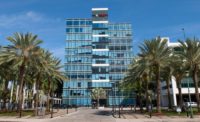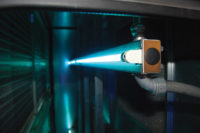Despite being recognized for significantly improving airflow and heat-transfer efficiency levels and lowering the costs associated with HVACR systems, ultraviolet light in the 253.7-nm germicidal C-band wavelength (UV-C) is often misunderstood and, therefore, under-utilized by HVACR contractors, mechanical engineers, and end users.
To help clear up common misconceptions and improve your understanding of how UV lamps operate, I’ve outlined these UV myths and facts.
FACTS
UV-C Kills Virtually Everything: Fact
ASHRAE has recognized that the 253.7-nm germicidal C-band wavelength inactivates virtually all microorganisms living on HVACR surfaces with a kill ratio of 90 percent or higher, depending on UV-C intensity, length of exposure, lamp placement, and lamp life cycle. In fact, a 2013 Centers for Disease Control and Prevention (CDC)-funded study conducted in two hospitals found that UV-C reduced the total number of colony-forming units of any pathogen in a room by 91 percent.
Science has yet to find a microorganism that’s totally immune to the destructive effects of UV-C, including superbugs and all other antibiotic-resistant microbes associated with health care associated infections.
UV-C Can Make Your HVACR System Perform Like New: Fact
As mold, biofilm, and other organic compounds accumulate on cooling coils and other HVACR surfaces, the system inevitably becomes less efficient at removing heat. This loss in heat transfer efficiency forces operators to compensate with more energy-intense adjustments.
In new HVACR systems with UV-C installed, such buildup won’t form because of the continuous 24/7/365 bombardment of UV-C energy. In retrofit applications, UV-C degrades the organic matter that has accumulated over time and then prevents it from returning — so long as the lamps are regularly replaced. The UV-C energy also penetrates deep into the coil to eliminate the buildup that cannot be reached by either mechanical (pressure washing) or chemical treatment. In other words, UV-C improves airflow and returns heat-transfer levels to “as-built” capacity, which translates to less energy needed to provide the necessary amount of cooling and airflow demanded by the building. UV-C installed in older systems can reduce system energy use by up to 25 percent.
UV-C Technology is Not New: Fact
To those unfamiliar, UV-C might seem futuristic. Something about that crisp, blue light screams science fiction. In fact, now known for delivering upwards of 25 percent energy savings, boosting airflow, and extending HVACR equipment life, UV-C technology got its start in the 1940s by providing cleaner, healthier air. One veteran facility manager who recently installed UV-C recalled, “I remember the lights being mounted over my doctor’s door to kill germs.” Furthermore, since the mid-1990s, UV-C has been used to significantly improve HVACR airflow and heat-exchange efficiency. UV-C lamps have truly withstood the test of time and have proven to be a credible means of completely destroying harmful microorganisms.
UV-C is Used in Homes: Fact
UV-C is not just for hospitals, office buildings, institutions, and data centers. That same technology can be put to use in residential HVACR systems to provide cleaner air, improve airflow, and raise heat-exchange efficiency levels. Certain manufacturers offer UV-C lamps that easily install on the exterior of the HVACR plenum and are ideal for all residential and most light commercial applications.
MYTHS
UV-C’s Primary Application in HVACR Systems is for On-the-fly Kill: Myth
UV-C does more than disinfect moving airstreams in HVACR systems and the upper air. Today, UV-C is a widely accepted means of surface irradiation throughout HVACR systems, meaning it can eliminate existing microbial buildup on drain pans, cooling coils, and other components. UV-C restores cooling capacity and airflow to return the air handler to as-built operating conditions in as little as 90 days. The 253.7-nm germicidal C-band wavelength reflects exceptionally well and deep into the coil to kill and degrade problematic biological contaminants.
UV-C Lasts Forever (No Bulb Changes Needed): Myth
It’s very easy to “install and forget” when it comes to UV-C lamps. Alas, nothing lasts forever. UV-C lamp manufacturers, like Philips, GE, etc., rate their lamp’s “useful life” at 9,000 hours or slightly more than a year when operating 24/7/365. At that point, the lamp’s output can fall to 85 percent of its original energy level. It’s, therefore, obligatory for facility managers to set up an annual lamp replacement schedule if they want to maintain continued performance and protect against equipment failure.
UV-C will Impact all Materials in an HVACR System Equally: Myth
There are many different materials found in HVACR systems, from metal to plastic to synthetic media, and all are impacted differently by UV-C. While metal is impervious to UV-C energy, plastic and synthetic media (filters) can be affected. Applying aluminum tape to plastic materials (electrical wires) will protect them from direct exposure. Likewise, UV-C lamps should not be installed in such a way as to expose synthetic filters typically found in residential and commercial HVACR systems to the UV-C energy.
UV-C Energy can Cause Permanent Damage to Human Health: Myth
Anything can be safe or dangerous depending on how it’s handled. The same applies to UV-C. Therefore, taking the commonsense steps of placing warning labels on access points to UV lamps, installing electrical disconnect devices (e.g. toggle switches and safety interlock switches), and educating service personnel and building occupants to avoid UV-C exposure is always recommended.
Accidental exposure to UV-C energy can cause erythema (reddening of the skin), which resolves over a short time (depending on exposure amounts). Exposure to the eyes can cause temporary inflammation of the cornea or conjunctiva, which typically resolves within 24-48 hours, depending on exposure time.
Viewport Glass Doesn’t Protect You from UV: Myth
A viewport on an air handler is the safest means of viewing the light. The glass used on typical viewports is not “pure” (e.g. quartz) and, therefore, blocks the UV-C bandwidth. Installers should ensure that the viewport is sized and located to allow an operating UV system to be viewed from outside of the air handler. Viewport windows may be checked for safety by using a radiometer tuned to the 253.7-nm germicidal C-band wavelength. Certain UV-C manufacturers offer in-the-field testing, which can confirm for contractors and HVACR engineers that the window is blocking the UV-C energy. A “UV-C Safe Glass” sticker can then be applied to the window.
UV-C is Expensive: Myth
It’s easy to think of UV-C as high-tech and, therefore, expensive, but that simply isn’t true. UV-C has an average installed cost of $0.15 per cfm, and many users report that their cost for an installed UV-C system featuring high output lamps was even less.
Using a 10,000-cfm system as the example, the installed UV-C fixtures would cost $1,500 with an annual operating cost of $188 at $0.10/kW — operating 24/7/365. That is less than 1 percent of the average power savings gained through a more efficient (better heat transfer and lower pressure drop) air conditioning system. Furthermore, field reports indicate the initial cost of a UV-C system is about the same as one properly performed coil-cleaning procedure and less when system shutdowns, off-hours work with the associated overtime, and/or contractor labor costs are considered. As a result, it might be more rational to make a one-time investment in a UV-C system that will keep cooling coils at as-built conditions.
UV-C Energy is Blue: Myth
The blue color visible in UV-C lamps does not come from the UV-C wavelength, which has no color. It’s actually the argon gas in a UV lamp that produces the blue hue. When an electrical current is applied to a lamp, it “excites” the mercury to generate a photon with a wavelength of 253.7 nm (typically called UV-C), which is invisible.
For more UV facts and figures, visit http://www.uvresources.com.
Publication date: 8/28/2017
Want more HVAC industry news and information? Join The NEWS on Facebook, Twitter, and LinkedIn today!












